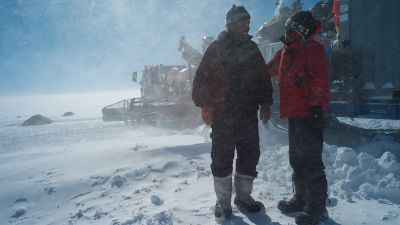
Bringing the JARE 51 Crew Back to Usteinen
There's a lot to get ready for the next flight. The satellite platform has to be anchored in the granite and assembled. The dish has to be built up before the technical team arrives. Alain, Koen, Paul, Bernard, Johan have been milling around the gigantic meccano, fretting over nuts and bolts. The weather is likely to change by the end of the week and the work has to advance.
By Tuesday, with work on the satellite dish advancing well, Alain could leave without guilt, so we packed one of the 10-foot containers and headed east to pick up the JARE 51 Eastern Sør Rondane Mountains Traverse Team. They had been in the the easternmost part of the Sør Rondanes hunting meteorites since the beginning of January.
Alain, Rene and I set off in Prinoth 4. Our plan was to swoop in and out in a quick, clinical operation before the arrival of the next team flight on Saturday, but things didn't work out that way. René took the first driving shift, I the second and Alain the third.
Time could drag at that speed, but somehow it doesn't. You settle into the comfortable seat, admire the mountains, eat soggy sandwiches, watch the GPS bearing and keep an eye on the hydraulic temperature gauge climbing sickeningly close to boiling, refuel, argue and nap.
Fifteen hours later, we limped triumphantly into the JARE-51 camp, with only one flat tyre, punctured by ice accretions. Everyone was asleep, so there was no welcoming committee. We ate noodles with shitake mushrooms and David's seafood stew, and dropped asleep, exhausted despite the howling wind.
"You've got two flat tyres", said Jesko in the morning, poking his head into the 10-foot container. We glared at him in disbelief. Jesko set about lifting the track with the crane on Prinoth 2 so that he could replace the tyre with the spare he had.
The Balchen pass lake was ice-free despite the bone-chilling cold. Without wind chill (which was -25°C), the air temperature was -7°C. Zorigto had given us some sterile sampling bottles to bring back samples of lake water and sediment, as well as measure the temperature of the water. The water was half a degree above freezing at the surface. Zorigto told us that he had measured and it was definitely not saline. So why would it not freeze? The geologists at Balchen say that there is no geothermal vent and that the water remains unfrozen only because of the rocks heating up. But it is difficult to believe them. Why only one spot out of three in the same area?
Back at the camp an hour later, the convoy was ready. We climbed out of the "bowl" in which the camp was located out onto the level plain of the glacier, with three sledges each. The geology team appeared and disappeared at various times during the day, but the convoy kept on track. Moving along at 11 km/h, we had to take another one hour detour to pick up the fuel depot at the geologists' camp. By evening, the JARE team looked frozen to the saddle while we were as warm as toast in the Prinoth cabin. Having safely navigated the Byrdbreen, it was safe to stop for the night.
The next morning, the combined horsepower of the Prinoths dragged the convoy out of the basin once again and we hightailed it back to Utsteinen. The hydraulic fluid began to overheat, so we threw on a couple of extra circuits to cool it a bit as we began the grinding climb back up the hill to the station.
Our relief was enormous. We invited the JARE team to dinner and it was a good time. Soon, they will be evacuated to Syowa, and from there begin the long sea journey back to Yokohama, the home port of the Shirase.
Nighat Amin
Picture: International Polar Foundation - © International Polar Foundation
